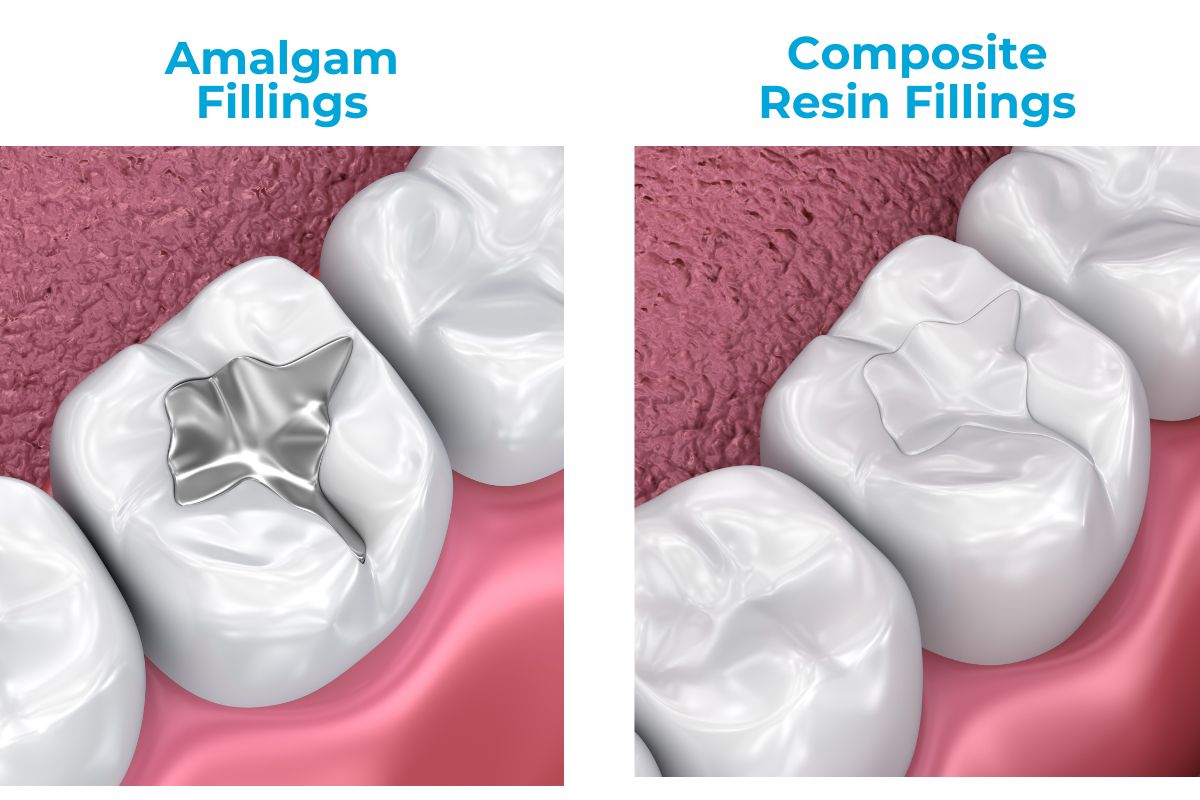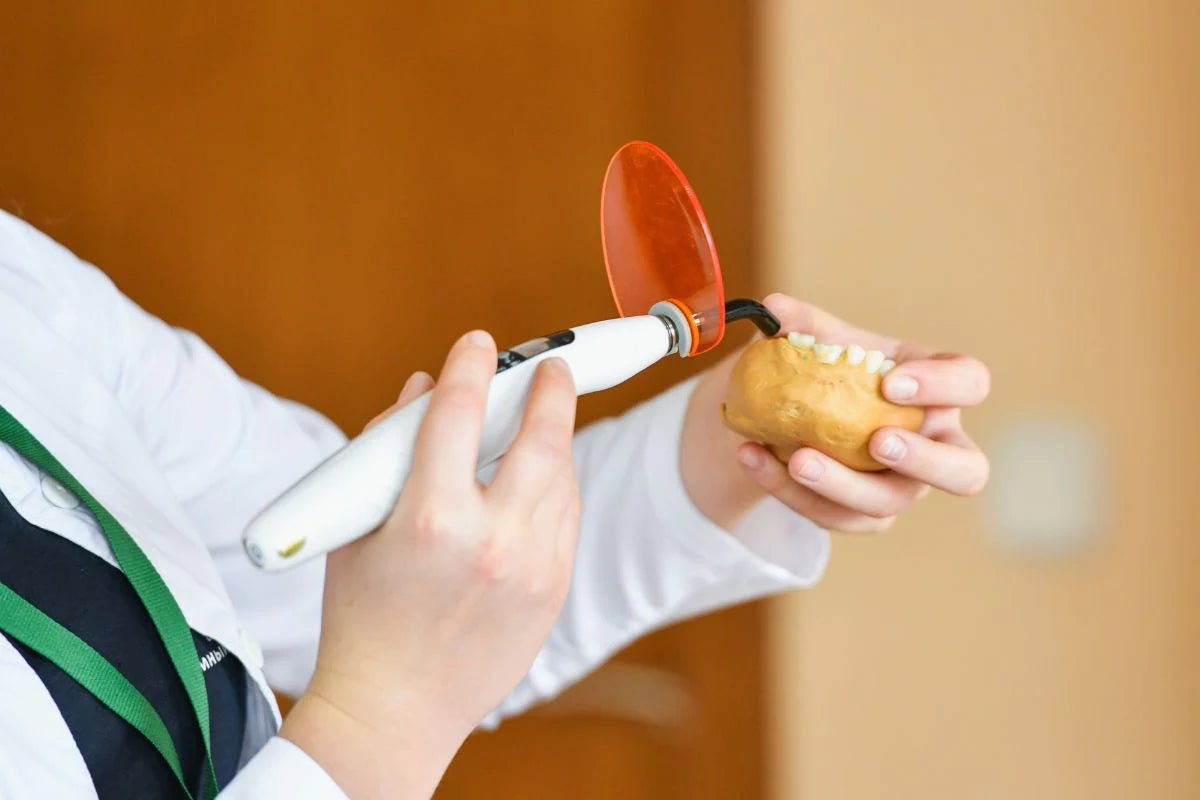Inlays vs. Onlays: What's the Difference?

Are you struggling to find the right dental restoration option to suit your needs? If so, it may be worth considering inlays or onlays. These restorative treatments are excellent for repairing damaged teeth and restoring their functionality.
This article compares inlays and onlays, exploring their differences, materials used, procedures, aftercare, and cost. Join us as we dive into the details and help you make an informed decision.
Inlays vs. Onlays
Inlays are a conservative and precise form of restoration that aims to preserve as much of the healthy tooth structure as possible.
They are recommended when there is damage or decay in a tooth that does not extend to the gumline. They are meticulously designed to fit within the cusps, effectively covering the area between them.
These procedures address tooth structure damage that is too extensive for dental fillings but not severe enough to warrant a dental crown.

On the other hand, a dental onlay is used when there is damage or decay that extends beyond the cusps of the tooth, potentially reaching the gumline or covering a larger area. Sometimes referred to as partial crowns, onlays provide coverage over a greater portion of the tooth compared to inlays.
They are designed to restore the damaged portion of the tooth, including the cusps, while also preserving the integrity of the healthy tooth structure, including the gumline.
Both options offer high durability and longevity. With proper care, they can last between ten to fifteen years. In fact, a study showed that the survival rate of both procedures is over 90%.
While both treatments can restore tooth structure and functionality, choosing the most suitable procedure depends on factors such as the extent of the damage, the tooth's location, and cost.
Furthermore, in addition to choosing the procedure, you can select the materials used for your onlays and inlays. But what are these materials, and how do they differ?
Materials Used for Inlays and Onlays
The longevity of these treatments is greatly influenced by the materials used. They can be crafted from amalgam or composite material. Remember that both amalgam and composite material can withstand pressure.
Composite resin is a tooth-colored material less expensive than porcelain and gold. It is durable and can blend seamlessly with your natural teeth. However, it is weaker than gold and porcelain, although it can perform the same function as the more expensive materials.
Porcelain, another popular material for inlays or onlays, can closely mimic the color of your natural teeth. It is highly durable and resistant to stains. However, it is more fragile than gold and more expensive than composite resin.
Gold, although rarely used in inlays and onlays due to its appearance and cost, is an exceptionally durable material. It is the most expensive option and easily noticeable due to its appearance. Dentists usually recommend gold for less visible areas, such as the back molars, especially if other materials are prone to fractures.
When choosing the material for your inlays or onlays, it is essential to consider the location and extent of the tooth damage, your desired appearance, and material cost. Again, seeking guidance from a dental professional will help ensure your procedure’s success.
Now that we have explored the materials, let's move on to the steps involved in obtaining successful inlays or onlays.
Procedure
Although inlays and onlays may differ in their ability to address specific dental issues, their procedures are nearly identical. The process typically involves two dental appointments to complete the restoration.
Here are the steps involved in the procedure:
Step 1: Tooth Examination
During the initial consultation, your dentist will thoroughly examine your teeth to determine which procedure suits your needs. This is also the time your dentist will discuss the available material options based on your tooth's requirements and personal preferences.
Step 2: Cavity Removal
After the examination and consultation, the existing cavity will be removed. Using local anesthesia, your dentist will numb the affected area. Then, the decayed or damaged part of the tooth will be removed, leaving an empty space where a filling will be placed.
Step 3: Tooth Impression
In the following step, your dentist will take an impression of your tooth, which will be sent to a dental laboratory to create permanent fillings. While you wait for the permanent restoration, your dentist will place a temporary filling material.
Step 4: Installation
Once your permanent inlays or onlays are ready, you will be scheduled for a second dental appointment. During this visit, your dentist will administer a local anesthetic to minimize discomfort while removing the temporary fillings. The permanent inlays or onlays will then be bonded to your teeth.
Your dentist will ensure that your preferred restoration fits perfectly and matches the color of your natural teeth. The onlays or inlays will be polished to achieve a seamless blend with your existing teeth.
After the procedure, it is normal to experience some discomfort and sensitivity, as removing part of your tooth exposes the nerves.
This sensitivity typically subsides within several days to a few weeks. However, if you continue to experience pain or discomfort beyond this period, it is advisable to consult your dentist to address any potential issues.
*Note that advancements in technology, such as CAD/CAM technology and milling machines like CEREC, now allow inlays and onlays to be fabricated and placed in only a single visit.

Aftercare
Proper aftercare is crucial for maximizing the lifespan of your fillings. While a skilled dentist and high-quality materials contribute to their longevity, they may not last as long as intended without adequate care. Here are some notable aftercare tips:
- Practice good oral hygiene by brushing your teeth at least twice daily and flossing regularly.
- Use mouthwash to eliminate any remaining food particles and bacteria.
- Avoid biting on hard, chewy, or sticky foods that may cause damage to the chewing surface.
- Minimize consumption of sugary foods to prevent tooth decay.
- Schedule regular dental check-ups to ensure the health and integrity of your newly restored teeth.
Pros and Cons
Like any dental procedure, inlays and onlays have their pros and cons. Understanding their benefits and drawbacks helps in determining the most suitable option, considering factors such as durability, aesthetics, cost, and tooth preparation requirements.
That said, here are the advantages and disadvantages of both options:
Pros of Dental Inlay
- Highly durable compared to traditional fillings
- Custom-made to precisely fit your tooth
- Can be made from materials that match the color of your teeth
- Less invasive than dental crowns
Cons of Dental Inlays
- More expensive than traditional fillings
- May not be suitable for extensive areas of tooth damage or dental decay
Pros of Dental Onlays
- Highly durable compared to traditional fillings
- Provide a more comprehensive and complete restoration compared to inlay
- Can be made from tooth-colored materials
- Custom-made to precisely fit onto your tooth
Cons of Dental Onlays
- More invasive than inlays and require more removal of healthy tooth structure
- More expensive than inlays
Ultimately, the final say on whether to proceed with an inlay or onlay procedure lies with the patient, as it is their oral health and well-being that are at stake.
However, the decision-making process should involve a collaborative effort between the patient and the dental professional.
The dentist or oral healthcare provider plays a critical role in guiding the patient, presenting treatment options, explaining the pros and cons, and offering their professional recommendations based on the patient's specific dental needs and circumstances.
The patient's preferences, concerns, and desires should be considered, but it is important to take into account the dentist's expert advice.
Cost and Insurance Coverage
The total cost of these procedures can vary depending on factors such as the chosen material and the location of the dental practice.
Without dental insurance coverage, they typically range from $650 to $1200 per tooth. However, if you have dental insurance, you can expect coverage ranging from 50% to 100% of the total cost, as inlays and onlays are considered major dental procedures. Your out-of-pocket expenses can range from $10 to $100, depending on your insurance plan.
It's essential to check with your insurance provider to understand the specific coverage details and any applicable limitations or restrictions. Your dental office can also assist you in navigating the insurance process and providing accurate cost estimates based on your case.
Key Takeaways
Less aggressive restoration techniques such as inlays and onlays are highly effective in addressing tooth damage that goes beyond what traditional fillings can handle, while also avoiding the need for a full crown.
These restorative treatments are particularly useful when the damage is significant enough to cause further decay or when the biting surface of the tooth is compromised.
Both inlays and onlays can be crafted from various materials such as gold, porcelain (ceramic), or composite resin.
These options ensure durability and offer natural aesthetics, blending seamlessly with your existing teeth. Your dentist will help you determine the most suitable material based on your specific needs and preferences.
To make a reasonable decision about whether inlays or onlays are right for you, it is important to consult and collaborate with your dentist.
They will assess the extent of the damage, consider the location of the affected tooth, and guide you in selecting the best option for achieving optimal oral health.
By opting for inlays or onlays, you can benefit from their durability and conservative approach, ensuring a successful restoration while preserving your natural tooth structure.
Restorative Dentist in Culver City
If you're seeking reliable and personalized dental care in Culver City, look no further than Culver City Dentist United Dental Care.
Our dedicated team is committed to providing top-notch dental services and helping you achieve and maintain optimal oral health. We proudly serve patients from Marina Del Rey, Santa Monica, Inglewood, Palms, and surrounding areas.
Don't delay your journey to improved dental health and overall well-being. Schedule an appointment with us today and experience the difference in quality dental care in a warm and welcoming environment.





